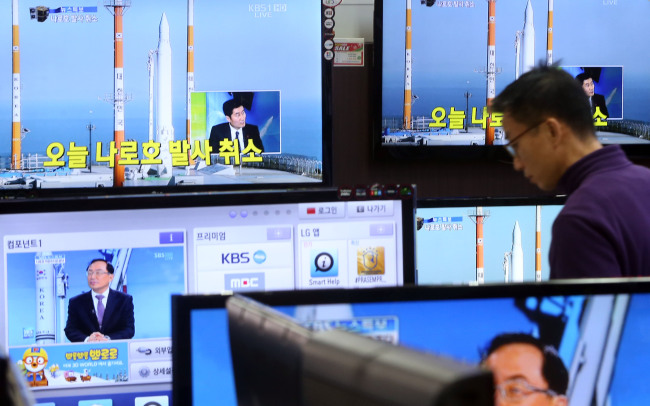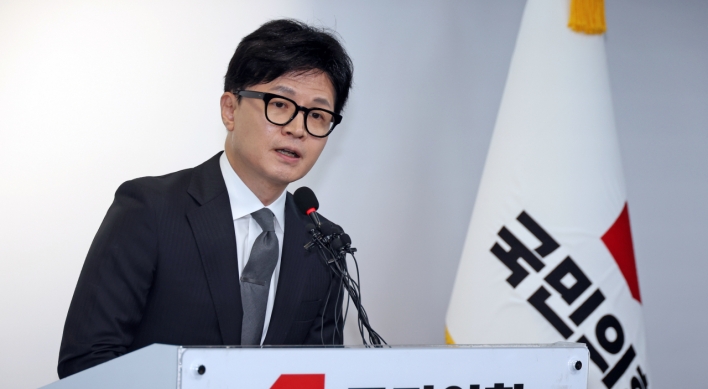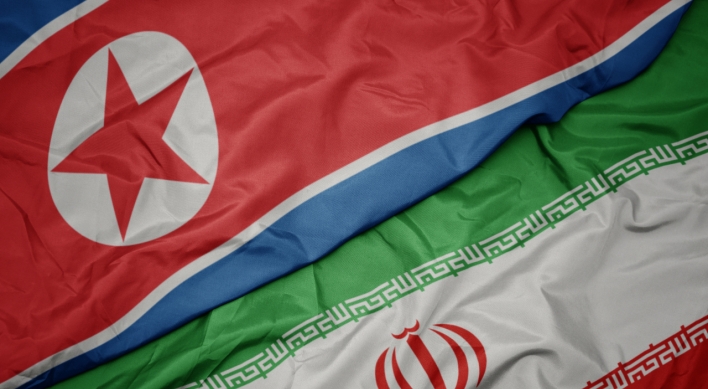Glitches do not deter Korea’s space program
Experts say Korea has already gained expertise from Naro
By Park Hyung-kiPublished : Nov. 29, 2012 - 20:06
Korea has once again canceled the launch of the Korea Space Launch Vehicle-1, or the Naro, on Thursday due to technical problems on the second-stage solid-fuel rocket’s thrust vector control system.
Given that this will make it the final attempt to blast the rocket, jointly developed by Russia and Korea, into space, Korea is playing it safe by making sure everything is in perfect order before launching the Naro one last time.
“Rockets require more than a million sophisticated components. One small default in a single part will result in a complete launch failure or cancellation,” said Park Chan-deok, professor of astronomy at Yonsei University.
“That is why it is so hard to build one. But it certainly provides more potential and returns in the long-run,” he added.
This was clearly shown in October when Korea had to call off its third KSLV-1 launch due to a technical glitch on the rocket’s helium supply system and rubber parts.
Then, it canceled the launch after detecting a leak through the rubber rings attached on an adaptor when supplying the helium, which gives the thrust to the first-stage liquid-fuel rocket made by Russia.
This time, officials saw a problem with the electronic thrust system for the upper rocket made by Korea.
After officially calling the whole thing off, the public was disappointed, and the media expressed the event by saying that the Naro has splashed “cold water again at the crowd.”
Given that this will make it the final attempt to blast the rocket, jointly developed by Russia and Korea, into space, Korea is playing it safe by making sure everything is in perfect order before launching the Naro one last time.
“Rockets require more than a million sophisticated components. One small default in a single part will result in a complete launch failure or cancellation,” said Park Chan-deok, professor of astronomy at Yonsei University.
“That is why it is so hard to build one. But it certainly provides more potential and returns in the long-run,” he added.
This was clearly shown in October when Korea had to call off its third KSLV-1 launch due to a technical glitch on the rocket’s helium supply system and rubber parts.
Then, it canceled the launch after detecting a leak through the rubber rings attached on an adaptor when supplying the helium, which gives the thrust to the first-stage liquid-fuel rocket made by Russia.
This time, officials saw a problem with the electronic thrust system for the upper rocket made by Korea.
After officially calling the whole thing off, the public was disappointed, and the media expressed the event by saying that the Naro has splashed “cold water again at the crowd.”

Experts, however, said these few obstacles should not strain Korea and its efforts to be part of the world with a very few economies that have strong space programs.
“Korea has gained a considerable amount of knowledge in rocket technology through past trials and errors,” said Lee Chang-jin, a professor of aerospace engineering at Konkuk University.
Korea must move on for the third Naro launch, as well as concentrate on developing its own proprietary KSLV-2 rocket by 2021.
It already has the capability to develop advanced satellites on a par with the U.S, Russia and the European Union.
But without the rockets, especially liquid-fuelores, those special-purpose satellites will remain on Earth being wasted. Or, Korea could continue to wait by the phone to hear from other foreign governments with rockets to see whether they can launch Korean satellites at a high price.
The very important lesson from this project is that developing rockets is not only extremely tough but also highly classified. Russia, with which Korea partnered for three launches, did not trade any of its long-standing secrets in rocket science as it concerns national security. It did, however, share its know-how in launch pad design and operations, which are equally important in running a space program.
“Satellites and rockets are what define one country’s space capability, and Korea already has strong know-how in satellites,” said professor Park.
Only after Korea launches its own domestic rockets into space can it call itself a space powerhouse equivalent to the U.S., Russia, Japan and China.
Therefore, it is imperative that the country keep its schedule to build them, especially liquid engine rockets by 2021, and secure full space tech capability by 2030, experts said.
Liquid-fueled rockets, which give the thrust for Mach 5 to 6, are highly complex, while solids are simple, which scientists described as filling fuel in an empty tin can.
This is the area where even North Korea is ahead of South Korea, noted professor Chang Young-keun of Korea Aerospace University.
The North’s test-fire of its Taepodong-1 using a liquid-fuel rocket in 1998 gave a political “wakeup call” to South Korea.
“But it has now become more than politics,” Chang said. “The level of space technology will define and compare our country with others over the next decade.”
Korea’s rocket technology level is mere 67 percent that of advanced economies.
China has shown it can dock, while India has launched a rocket to the moon.
Experts reiterated that Korea needs to increase its budget for KARI, which is extremely low compared with space agencies of the U.S. and Japan, or even when comparing with Korea’s gross national product.
Japan’s JAXA spends more than five times KARI, and the U.S. NASA 50 times.
“Korea’s space industry as a latecomer has to implement a ‘fast catch-up strategy then lead’ at the moment as the country has successfully done it with industries such as steel, automobiles, semiconductors and shipbuilding,” said Prof. Lee of Konkuk University.
By Park Hyong-ki (hkp@heraldcorp.com)
Chronology of Naro program
● March 2001 ― Korea joins the Missile Technology Control Regime.
● August 2002 ― Korea and Russia confirm plans to develop the Korea Space Launch Vehicle-1.
● Sept. 21, 2004 ― Korea and Russia sign a space technology cooperation pact.
● Oct. 26, 2004 ― The Korea Aerospace Research Institute signs a cooperative pact with Russia’s Khrunichev State Research and Production Space Center.
● 2005 ― Korea and Russia complete work on critical designs for the KSLV-1. The original launch date, set for 2005, is postponed until October 2007.
● September 2006 ― The engineering model for the upper part of the rocket is completed.
● Oct. 17, 2006 ― Korea and Russia sign a technology safeguard agreement.
● July 2007 ― The critical design for land-based launch support facilities is acquired.
● September 2007 ― The qualification model of the upper part of the rocket is completed.
● November 2007 ― A critical design review of the rocket is conducted by Korean and Russian engineers.
● December 2007 ― Revisions to the cooperative pact are implemented, with a new launch date set for late 2008.
● August 2008 - Russia builds a ground test vehicle for the main booster of the KSLV-1. Seoul says the first space rocket may be launched in the second quarter of 2009.
● May 10, 2009 ― Korea selects “Naro” as the name of its first space rocket.
● June 2009 ― Korea opens the Naro Space Center. Launch pad certification is completed using the KSLV-1 GTV. A complete first-stage rocket arrives from Russia by plane.
● Aug. 19, 2009 ― Korea halts the countdown of the KSLV-1 with less than eight minutes remaining after the automatic launch sequence system detects a problem in a high-pressure tank.
● Aug. 25, 2009 ― Korea fails to send a satellite into orbit.
● June 9, 2010 ― The launch of KSLV-1 is aborted with three hours left on the clock after emergency fire extinguishers activate.
● June 10, 2010 ― The KSLV-1 explodes 137.19 seconds after liftoff.
● July 19, 2012 ― The National Space Committee approves a third launch of the KSLV-1.
● Oct. 26, 2012 ― The scheduled launch of the KSLV-1 is delayed indefinitely due to a damaged rubber seal in the connector between the rocket and its launch pad.
● Nov. 22, 2012 ― The Launch Preparation Committee announces the third launch of the KSLV-1 will take place on Nov. 29.
● Nov. 29, 2012 ― The launch was postponed again due to technical problems.



![[Exclusive] Korean military set to ban iPhones over 'security' concerns](http://res.heraldm.com/phpwas/restmb_idxmake.php?idx=644&simg=/content/image/2024/04/23/20240423050599_0.jpg&u=20240423183955)

![[Graphic News] 77% of young Koreans still financially dependent](http://res.heraldm.com/phpwas/restmb_idxmake.php?idx=644&simg=/content/image/2024/04/22/20240422050762_0.gif&u=)



![[Pressure points] Leggings in public: Fashion statement or social faux pas?](http://res.heraldm.com/phpwas/restmb_idxmake.php?idx=644&simg=/content/image/2024/04/23/20240423050669_0.jpg&u=)









